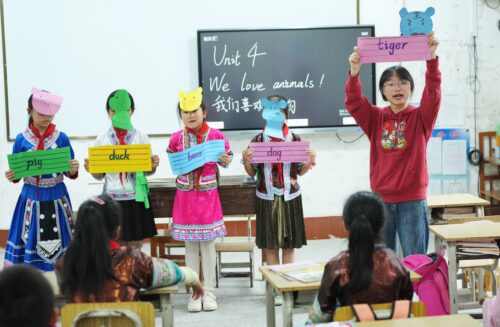John Pomfret: Chinese cash at American colleges is a massive problem
The “success story” of U.S.-China engagement through higher education is in crisis. Big time.

Ruobing came to America last spring on a special program at the University of California, Berkeley, to study English. After a semester, her English hadn’t really improved. Over a coffee at a Berkeley café, she struggled to express herself in English and then switched into her native Mandarin.
“I spend my free time with Chinese, my countrymen,” she said. “There are so many Chinese students here that we don’t really need to get to know Americans. And that means our English remains poor.”
Ruobing’s halting progress in English has not stopped an American university from accepting her as an undergraduate. This fall, she will be attending a major university in the Midwest, where there are more than 2,500 other Chinese, about 6 percent of the student body.
“When I think about it,” said Ruobing, who asked that her real name not be used, “that’s too many Chinese.”
Out of the almost 1 million foreign students attending U.S. universities this fall, almost one in three will be Chinese. This marks a fivefold increase over the 2004–2005 academic year, when there were 62,523 Chinese students stateside.
For years, these booming numbers were seen as a godsend, benefiting America’s relationship with China and even, some argued, America’s imbalanced trade with China. Experts opined that American education would bind Chinese to the United States and cement ties of friendship between both peoples. American students would learn firsthand about China, an increasingly important country and its culture. America at large would profit mightily from an inbound Chinese brain drain of entrepreneurial talent as many Chinese graduates would opt to stay in the USA. (Silicon Valley is littered with firms started by Chinese immigrants.) American education and Chinese demand for it were a true “win-win” in a relationship challenged to find examples of genuine progress in the recent past.
Too many Chinese students on U.S. campuses?
Increasingly, however, there’s a sense that even this success story is in crisis. To be sure, only a few observers (and that link is to a tweet, not an academic paper) have come forward to declare there are too many mainland Chinese students in the United States. But in private, many educators and students acknowledge that, as the dean of one private university put it in an internal email that was circulated in academic circles and shared with me, U.S. institutions face an “endemic and terrible problem” with mainland Chinese students, adding, “I don’t know that anyone has any great remedy.”
The business of educating Chinese
America has been in the business of educating Chinese almost as long as America has been in business itself. The first Chinese student, a southerner named Yung Wing 容闳, graduated from Yale University in the 1850s. Yung Wing then came up with a scheme to bring hundreds of Chinese boys to Hartford, Connecticut, where they went to local schools and later attended universities. Christian missionaries built scores of Christian colleges and high schools in China. And the U.S. government poured millions of dollars into a fund to educate Chinese and to build Tsinghua University, today considered China’s version of MIT. By the 1910s, Chinese had outpaced Canadians as the biggest foreign-born population on U.S. campuses.
Over the years, America’s goals for educating Chinese changed. When the United States began welcoming Chinese students in large numbers in 1905, Edmund J. James, the president of the University of Illinois, predicted that it would guarantee America’s “intellectual and spiritual domination of [China’s] leaders.”
In 1978, a different goal informed the American decision to renew educational exchange as it prepared to normalize relations with the People’s Republic of China. Then the idea was to create bonds of friendship between the two countries and exert what later came to be known as America’s “soft power” on the hearts and minds of the Chinese.
Americans added another reason to admit Chinese students in the 2000s, following China’s entry into the World Trade Organization and explosion onto the world stage as an economic force. This time, it was more diversity on American campuses and an opportunity to expose young Americans to students from this new and important power.
Today, however, another goal has begun to overshadow all the others. It’s money. Both private and public universities are aggressively marketing themselves to Chinese students because they want Chinese who can pay full tuition. For America’s state schools, faced with diminishing resources and budget cuts, the prospect of thousands of Chinese students paying full freight is too good to be true. For them, Chinese cash has become more important than Chinese students or the course of U.S.-China relations.
Cash-strapped institutions like the University of Minnesota have marketed heavily in China. In 2007, there were only 150 Chinese students there. In September, there will be close to 3,000. The University of Illinois at Urbana-Champaign — the same university that Edmund J. James led in the 1900s — has been dubbed the “University of China at Illinois.” Thirty-seven Chinese undergraduates enrolled there in 2000. This September enrollment will probably break 3,000, most of them paying full tuition. Oregon State reportedly added 300 tenure track positions thanks to tuition paid by foreign students, led by mainland Chinese.
Private institutions are also deeply enamored with mainland students. Rich Chinese parents or graduates are now viewed as potentially huge donors and some of the gifts — $115 million for a neuroscience center at CalTech, $8.88 million for the Yale School of Management, $15 million for a group of Ivy League colleges — are indeed prodigious.
A broken educational model?
If this obsession with Chinese cash prompted a wave of great Chinese applicants to U.S. universities, it would have been fine. Instead, it’s triggered a tsunami of fraud. Chinese families, eager to get their sons and daughters admitted to U.S. schools, contract with agents that are often paid a bounty by U.S. universities for each student accepted by the school.
Deception courses through the system. SATs and the TOEFL exams are taken by what the Chinese call “ghosts,” who are paid for high scores. Grades are made up. Letters of recommendation are forged. As far back as 2010, Zinch China, a consulting firm, warned that 90 percent of the recommendations coming from China were fake, 70 percent of personal essays were written by someone else, and 50 percent of high school transcripts were forged. Another survey done in 2012 of 25,000 Chinese students interested in coming to America to study found that English-language skills were actually declining; two-thirds could not speak English well enough to hack it at American schools.
The result? In this year’s entering class, there will be thousands of Chinese students who lack the education, the language ability, and the critical facilities necessary to benefit from an American education. That’s because many of them were given a slot at a U.S. university almost solely based on their parents’ ability to pay.
Accepting large numbers of unprepared mainland Chinese to an American college does not serve anyone’s interests. For one, many of the Chinese don’t get an education, skating through college on the backs of services that offer to take their tests and write their papers. What’s more, compared with my Chinese friends who studied in America in the 1980s, many of these Chinese students don’t really want to be in the United States. They’re sent here by their parents, who believe that a U.S. diploma is the ticket to either a better life in China or the fulfillment of their family’s plans to immigrate to America. These students end up hanging out with their compatriots, never making an American friend, and returning home with no appreciation of American civil society, its freedoms of association, speech, and religion, or its democracy. In fact, many I have spoken with can be openly hostile to Western values.
Secondly, the preponderance of ill-prepared Chinese engenders resentment among other students and faculty. Mainland Chinese students now dominate some majors and graduate programs in the United States. In some cases, that’s because they are the best students. But in other cases, the effect is not completely salutary. At Oregon State, the school’s master’s of business in accountancy now has more Chinese than American students, the Wall Street Journal has reported, leading one professor to wonder whether he needed to modify the original focus of the course. A friend of mine’s son at a liberal arts college in Pennsylvania observed that he and his classmates assume that most mainland Chinese students don’t understand that the school’s honor code is something that must be respected, not worked around.
The large number of Chinese students lacking the skills for a U.S. education is also partly responsible for another problem — the outsize influence of the Chinese Students and Scholars Association (CSSA), a state-supported Chinese organization involved in monitoring the political loyalty of Chinese students and professors.
Chinese governments have scrutinized the behavior of Chinese students in the United States since Chinese first began coming to America in larger numbers in the 1870s. The Qing court shut down Yung Wing’s Hartford experiment after Chinese minders who accompanied the boys in America complained that they were becoming too Americanized. In the 1940s, Republican China spied on Chinese students in the U.S., and today the Communist government — in part through the CSSA — has also taken steps to limit the effect that the American ideals of freedom of speech, assembly, and religion have on Chinese students.
While the Chinese Students and Scholars Association also engages in innocent activities, such as socials and events to introduce Chinese culture to a wider audience, its political work runs directly counter to the ideals of a Western education and represents a worrying trend of China attempting to export its system of thought control onto America’s shores. Chinese not prepared for an American education naturally gravitate toward the CSSA. “It offers us a place to go when we’re homesick,” observed Ruobing. “That makes it easier for them to ‘wash our brains.’”
Envoi
To be sure, steps have been taken to try to deal with the crisis. There are two organizations in China, both approved by China’s ministry of education, that can verify academic documents. Testing services, such as the College Board and the Educational Testing Service, have redoubled efforts to prevent “ghost” test takers. More and more schools are requiring interviews via Skype or even face to face. However, most experts acknowledge that much more needs to be done. Not every American university uses the verification process to authenticate transcripts. Too many still rely on dubious agents. And penalties given to cheaters on the SATs are considered too light.
“It blows my mind that students who cheat on the SATs get to take the test again — why aren’t they outed to all of your schools?” declared Hamilton Gregg, a longtime educational adviser in China. Gregg entitled a 2015 blog post “Is the Admission Process Broken?” His answer was yes.
Read two responses to this piece, also published on The China Project:





